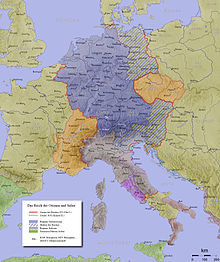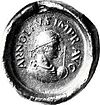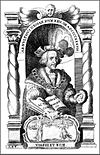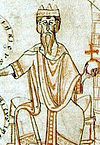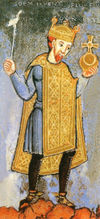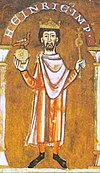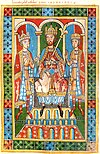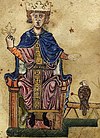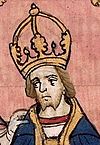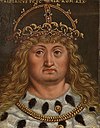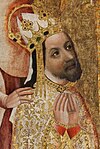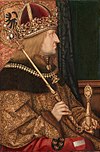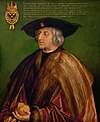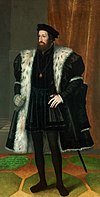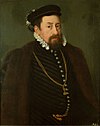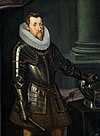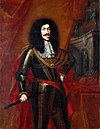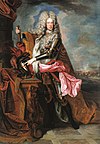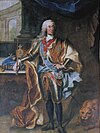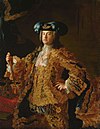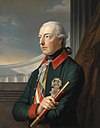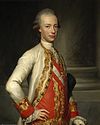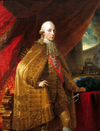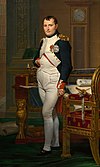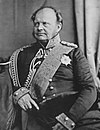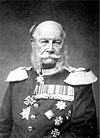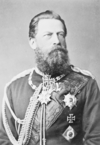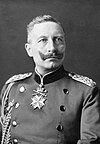
The Holy Roman Empire, also known as the Holy Roman Empire of the German Nation after 1512, was a polity in Central and Western Europe, usually headed by the Holy Roman Emperor. It developed in the Early Middle Ages and lasted for almost 1,000 years until its dissolution in 1806 during the Napoleonic Wars.

The Holy Roman Emperor, originally and officially the Emperor of the Romans during the Middle Ages, and also known as the Roman-German Emperor since the early modern period, was the ruler and head of state of the Holy Roman Empire. The title was held in conjunction with the title of king of Italy from the 8th to the 16th century, and, almost without interruption, with the title of king of Germany throughout the 12th to 18th centuries.
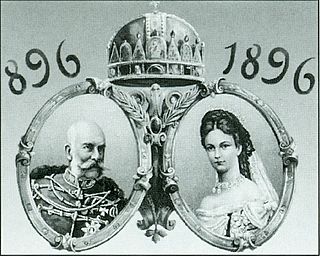
Kaiser is the German word for "emperor". In general, the German title in principle applies to rulers anywhere in the world above the rank of king (König). In English, the (untranslated) word Kaiser is mainly applied to the emperors of the unified German Empire (1871–1918) and the emperors of the Austrian Empire (1804–1918). During the First World War, anti-German sentiment was at its zenith; the term Kaiser—especially as applied to Wilhelm II, German Emperor—thus gained considerable negative connotations in English-speaking countries.

The North German Confederation was initially a German military alliance established in August 1866 under the leadership of the Kingdom of Prussia, which was transformed in the subsequent year into a confederated state that existed from July 1867 to December 1870. A milestone of the German Unification, it was the earliest continual legal predecessor of the modern German nation-state known today as the Federal Republic of Germany.

King of the Romans was the title used by the king of East Francia following his election by the princes from the reign of Henry II (1002–1024) onward.

King of Italy was the title given to the ruler of the Kingdom of Italy after the fall of the Western Roman Empire. The first to take the title was Odoacer, a barbarian warlord, in the late 5th century, followed by the Ostrogothic kings up to the mid-6th century. With the Frankish conquest of Italy in the 8th century, the Carolingians assumed the title, which was maintained by subsequent Holy Roman Emperors throughout the Middle Ages. The last Emperor to claim the title was Charles V in the 16th century. During this period, the holders of the title were crowned with the Iron Crown of Lombardy.

East Francia or the Kingdom of the East Franks was a successor state of Charlemagne's empire ruled by the Carolingian dynasty until 911. It was created through the Treaty of Verdun (843) which divided the former empire into three kingdoms.

The German Emperor was the official title of the head of state and hereditary ruler of the German Empire. A specifically chosen term, it was introduced with the 1 January 1871 constitution and lasted until the official abdication of Wilhelm II on 9 November 1918. The Holy Roman Emperor is sometimes also called "German Emperor" when the historical context is clear, as derived from the Holy Roman Empire's official name of "Holy Roman Empire of the German Nation" from 1512.

The Kingdom of Germany or German Kingdom was the mostly Germanic-speaking East Frankish kingdom, which was formed by the Treaty of Verdun in 843, especially after the kingship passed from Frankish kings to the Saxon Ottonian dynasty in 919. The king was elected, initially by the rulers of the stem duchies, who generally chose one of their own. After 962, when Otto I was crowned emperor, East Francia formed the bulk of the Holy Roman Empire, which also included the Kingdom of Italy and, after 1032, the Kingdom of Burgundy.

The Kingdom of Italy, also called Imperial Italy, was one of the constituent kingdoms of the Holy Roman Empire, along with the kingdoms of Germany, Bohemia, and Burgundy. It originally comprised large parts of northern and central Italy. Its original capital was Pavia until the 11th century.

An anti-king, anti king or antiking is a would-be king who, due to succession disputes or simple political opposition, declares himself king in opposition to a reigning monarch. The term is usually used in a European historical context where it relates to elective monarchies rather than hereditary ones. In hereditary monarchies such figures are more frequently referred to as pretenders or claimants.

The German Empire was a proto-state which attempted, but ultimately failed, to unify the German states within the German Confederation to create a German nation-state. It was created in the spring of 1848 during the German revolutions by the Frankfurt National Assembly. The parliament elected Archduke John of Austria as its provisional head of state with the title 'Imperial Regent'. On 28 March 1849, its constitution was implemented and the parliament elected the king of Prussia, Frederick William IV, to be the constitutional monarch of the empire with the title 'Emperor of the Germans'. However, he turned the position down. The empire came to an end in December 1849 when the Central German Government was replaced by a Federal Central Commission.
The Imperial Plan of 1870 was a diplomatic initiative set out by the Prussian Minister President and Federal Chancellor of the North German Confederation, Otto von Bismarck. Accordingly, the Prussian King was able to assume the title of German Emperor.
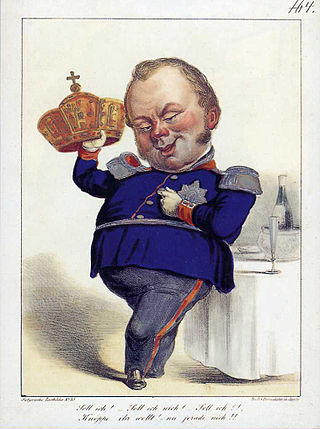
The question of an Imperial Sovereign or emperor was a central issue in Germany's attempts at unification from 1848 to 1850. Both the draft constitutional act with its provision for centralised power as well as the constitutional plans at that time, laid down how a German head of state would be selected for office and what rights they were to have.

Präsidium des Bundes or Bundespräsidium was a title under the German Confederation whereby the Austrian delegate held the chair of the Federal Assembly. Austria was thus called the presiding power. This did not give Austria extra competencies: its delegate simply led the proceedings of the Federal Assembly.

Reichsminister was the title of members of the German Government during two historical periods: during the March Revolution of 1848/1849 in the German Reich of that period, and in the modern German federal state from 1919 to the end of the National Socialist regime in 1945.
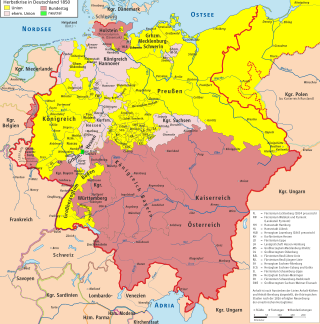
Autumn Crisis or November Crisis is the name given to a political-military conflict in Germany in 1850. In this conflict, the ultra-conservative Austrian Empire led those German states that wanted to restore the German Confederation after the revolution of 1848-1849, while Prussia wanted to create a new federal-state. This almost led to war in Germany, which was finally avoided by Prussia's backing down.
A Reichsverweser or imperial regent represented a monarch when there was a vacancy in the throne, such as during a prolonged absence or in the period between the monarch's death and the accession of a successor. The term Verweser comes from the Old High German firwesan and means "for or in the place of a person". The plural form is the same as the singular.
